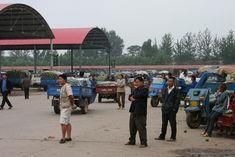
China has changed dramatically in the past 10 or 15 years, and fresh produce epitomises the changes in a graphic way. In the early 1990s you would struggle to find more than four varieties of fresh vegetables on sale in cities, with green cabbage - the so-called patriotic vegetable - in pole position. Now, the markets are full of every imaginable variety of fruit and vegetable, mostly of good quality. The Chinese home-grown industry has really progressed.
Many UK growers see this as an immediate threat to their own production, and in some ways they may be right, but that is looking at the situation in the most pessimistic way, and there are other ways of viewing the scene.
Firstly, all land in China is owned by the state, the People’s Republic of China. Land is leased to people or companies for specific purposes, and the protection of agricultural land is a high priority for the national government which is keen to avoid large swathes of China being built upon at the expense of the agri-food sector’s ability to produce enough food to feed its population of more than 1.3 billion. Owing to the nature of land leases, and the general lack of any established commercial trading system, banks are reluctant to lend against the security of the leased land. This has denied some Chinese farmers access to capital to develop their businesses.
About 30 per cent of agricultural production is wasted. This appallingly high figure reflects the lack of a robust post-harvest system, and also a lack of co-ordination between producers and customers, often in different provinces. Here, the solution lies in improving growers’ awareness of customer needs - always an issue in a centrally planned economy - and in creating a robust chill-chain and distribution system.
Yields are far lower than in the UK. Some protected crops may be yielding only a twentieth of the production expected in the UK. This is despite soil fertility being generally high, and the abundance of inexpensive labour meaning that farmers and growers can afford to pay someone to keep an almost constant eye on the production site. While Chinese research centres are truly excellent, conducting some really leading-edge work, including propagation in space, this does not always translate into efficient production on the ground. Here is a real opportunity for UK farmers and growers to provide know-how and, even, varieties on a commercial basis.
Historically, China allowed foreign involvement in businesses after the relaxations of the late 1980s through joint ventures. These were fraught with problems. Probably the most accurate yet depressing account of the jv system over the period from 1994-2004 is contained in Tim Clissold’s book Mr China in which he details how he and his colleagues lost more than $400 million (£202.5m) through that period. Partly as a result of those bad experiences, the pragmatic Chinese government introduced a new category of business, the Wholly Foreign Owned Enterprise (WFOE), which has enabled UK businesses to create ventures in China with Chinese partners, through a company registered in this country and subject to the trading laws of the UK.
Chinese prime minister Win Jo Bao, speaking at the EU-China Business Summit in Helsinki last autumn, made agricultural development through foreign involvement one of the planks of the administration’s future focus. He recognised the need to stop the waste, improve yields, and reduce the pollution caused by almost every type of Chinese enterprise today.
So how can we respond to this great opportunity? Firstly, there is a real need for know-how in breeding, crop management, protected crop environments, pesticide usage reduction, harvesting, post-harvest issues, and storage. Some UK businesses are already out in China transferring their technology on commercial terms. But much more can be done.
Then, secondly, becoming involved in a farming enterprise for out-of-season sourcing is worth exploring. And thirdly, some are viewing the opportunity as simply a new business venture where their know-how and maybe a bit of capital can be put to use in China to make a good return for those growers interested in supplying their home market in a more efficient and viable way.
Hartington China created the first British Pavilion at the China Agricultural Trade Fair in Beijing last October. This is the biggest national exhibition of fresh produce and food, and a major showcase for China’s fast-developing produce sector. We plan to be there in even greater strength in October 2007 and we would urge all UK businesses to come and see the opportunities for themselves.
Contact Richard Bruce, president of Hartington China, at r.bruce@hartington.com or 020 7100 1890.



